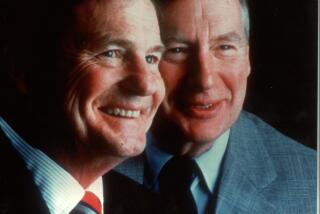1st Real Test of Pentagon Program : Media Pool Launched for U.S. Mission in Gulf
- Share via
WASHINGTON — The Pentagon activated its Defense Department Media Pool for the first time in an actual military operation, it was disclosed Tuesday with the transmission of the first dispatches by reporters aboard two of the Navy warships assigned to convoy reflagged Kuwait tankers in the Persian Gulf.
But journalists aboard a chartered launch who were not part of the 10-person pool were warned to stay away from two tankers while Marines in a helicopter leveled machine guns at them, according to a report from the United Arab Emirates. The journalists left without incident.
In announcing activation of the media pool, Pentagon spokesman Robert B. Sims said that information in dispatches from members will be withheld “until such times as conditions permit” to avoid endangering the escort mission. The operation was expected to get under way today.
He said the delays will not constitute censorship. “We don’t censor the pool reports,” he said. “What we get is what we send--warts and all.”
The pool was the seventh one activated in the aftermath of the 1983 U.S. invasion of Grenada, during which the Pentagon barred the media from covering the operation during its first three days.
But it was the first pool assigned to a legitimate military operation, not a drill.
Under the pool concept, a small group of reporters and photographers is formed under strict secrecy to accompany U.S. military forces. While the pool reporters must accept military restrictions on when they can file reports, the system does ensure that independent reporters will be on hand to observe military operations and eventually report what they saw.
The pool system, worked out by the Defense Department and news media, was first tested in April, 1985. That test was considered an abysmal failure as word of its activation leaked out just hours after reporters were told to stand by.
Each succeeding test, however, has seen an improvement in the procedures, and military secrecy has been maintained.
Activation of the pool began with a Pentagon call to Washington bureau chiefs of news organizations beginning at 9 p.m. EDT Saturday. It remained secret until the filing of dispatches by pool reporters on Tuesday.
The group took off in a military jetliner from Andrews Air Force Base outside Washington for the gulf region at 2 a.m. Sunday.
Defense Secretary Caspar W. Weinberger “immediately approved” the release of the first pool dispatch once it arrived at the Pentagon, Sims said.
The pool, split five and five between the cruiser Fox and the destroyer Kidd, will accompany the convoy from the Gulf of Oman, through the Strait of Hormuz and up the Persian Gulf to Kuwait, Sims said.
Pool representatives included an Associated Press reporter, a United Press International photographer, an ABC radio correspondent, a Cable News Network television crew, a Time magazine reporter and photographer and reporters from the Washington Times and Knight-Ridder Newspapers.
Sims again warned journalists covering the gulf region to avoid traveling in planes, helicopters or small boats to areas where Navy warships were operating.
“The hazard is that it’s an area of operations in which there is an increased alert by our units,” he said. “We do not find it amusing to find news organizations trying to get close to our own ships.”
A Navy officer in the gulf also was not amused when a launch hired by a group of journalists approached the tankers Bridgeton and Gas Prince, which hoisted U.S. flags Tuesday, and three warships anchored in the Gulf of Oman, a Reuters news agency dispatch said.
A destroyer blocked the launch, and the officer radioed a warning: “Change course now. Come no closer for your own safety.”
The journalists, including U.S. television crews, pleaded to be allowed to approach but the unidentified officer said: “Stay away. Don’t come closer than one mile.”
Then he added, “Sorry if the media can’t get good pictures but I have orders to keep you one mile off.”
The launch kept its distance.
More to Read
Sign up for Essential California
The most important California stories and recommendations in your inbox every morning.
You may occasionally receive promotional content from the Los Angeles Times.













